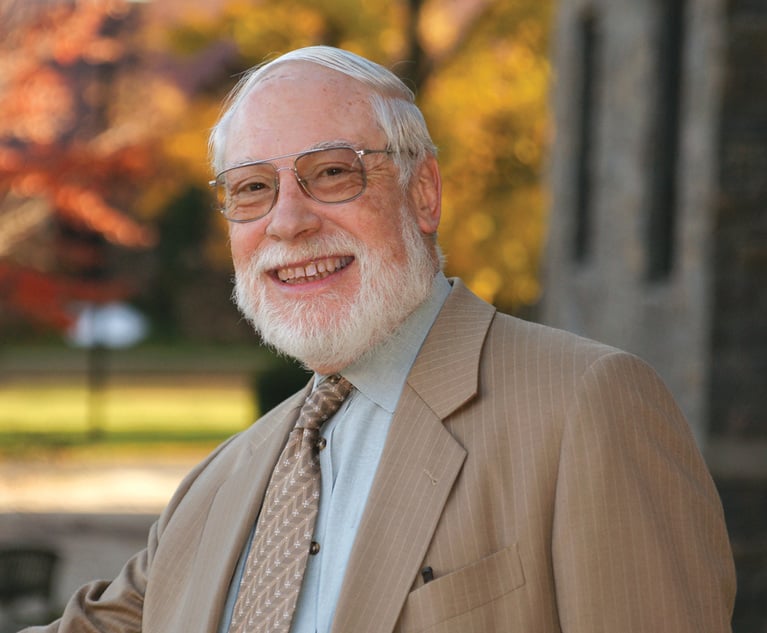New Law Ends Disparity in Appellate Representation
In a momentous development for criminal defendants in New York, the gap has been closed.
November 15, 2019 at 12:00 PM
5 minute read
 (Photo: Bigstock)
(Photo: Bigstock)
Until recently, there was a huge hurdle for criminal defendants who sought to attack their convictions based on innocence or errors, demonstrable by evidence outside the record: They had no right to counsel. A new law removes that hurdle.
The vehicle for these situations is not the direct appeal, which is based on a review of the trial record. Instead, a CPL 440.10 motion, asking the trial court to set aside the judgment of conviction, must be filed. The most common claim is ineffective assistance of counsel. Defective representation takes many forms, including the failure to make a dispositive motion; erroneous advice on immigration consequences; and the failure to do an investigation or use an expert.
Standards vs. Practice
In theory, any attorney assigned to an appeal should consider whether a post-conviction application might be warranted. That is what the Criminal Justice Section Standards of the American Bar Association and the Appellate Standards and Best Practices of the New York State Office of Indigent Legal Services say. Those standards indicate that a defendant's rights might not be adequately protected when counsel limits representation to the direct appeal.
New York City's institutional appellate defenders and a few defender offices outside the City, have vibrant post-conviction practices. But for "18-B counsel"—private attorneys who take assignments under County Law article 18-B and handle many upstate appeals—there has been a disconnect between standards and practice. Some appellate courts may grant permission for a post-conviction motion, but practices are not formal or uniform. Uncertainty about compensation may dissuade counsel from making these motions.
Until a trial judge ordered an evidentiary hearing to resolve the motion, there was no statutory right to counsel for a CPL article 440 motion. Two Catch-22s were built into that situation. First, how could a pro se defendant be expected to do an effective enough job to win the right to a hearing? Second, appellate decisions frequently declare that the record is inadequate to decide ineffective assistance claims; such issue often involves matters outside the courtroom, including counsel's purported strategic reasons for action or inaction. The reviewing court will state that the defendant must do a CPL 440.10 motion, yet often no attorney is assigned to give the defendant a fighting chance.
Momentous Amendment
In a momentous development for criminal defendants in New York, the gap has been closed. Last summer, lawmakers passed a bill to amend to County Law §722 to provide that the attorney assigned to a direct appeal—or a trial 18-B attorney—can do a CPL 440.10 motion and be compensated. On November 8, Governor Cuomo signed the bill into law, and it went into effect immediately. The bill also authorizes assigned attorneys to do CPL 440.20 motions seeking to set aside illegal sentences. Such applications are typically not time-consuming compared to 440.10 motions, yet they can result in sizeable reductions in clients' sentences.
The bill, sponsored by Assemblywoman Vivian Cook, D-Queens, and Sen. Jamaal Bailey, D-Bronx, provides for reform long championed by the New York State Defenders Association (NYSDA) and Alfred O'Connor, formerly Senior Litigation Counsel at NYSDA. See Alfred O'Connor, "Bill Seeks to End Disparity in Scope of Appellate Representation," NYLJ (Nov. 9, 2018).
In anticipation of the new law, a session on CPL article 440 motions was included in a recent appellate training program in Albany presented by the State Office of Indigent Legal Services and NYSDA earlier this year. Presenter Claudia Trupp, Director of the Justice First and Client Re-entry Projects at the Center for Appellate Litigation (CAL) in NYC, gave the attendees guidance in, and a glimpse of, the power of CPL 440.10 applications.
Post-Conviction Investigation
She described a client who was convicted of a sexual assault against another Rikers Island inmate and sentenced to 20 years to life. The client was so adamant that he was innocent that Trupp delved deep. She tracked down other inmates. They said that nothing happened. She read deposition transcripts from a civil lawsuit brought against the state by the purported victim. The correction officers deposed said nothing happened. Trupp visited the Rikers cell block. It was impossible for the crime to have occurred as the complainant had testified. She obtained a Corrections report revealing that the complainant told another inmate that he was going to make up a sex scandal to get off the cell block.
That was Trupp's first post-conviction case. In the ensuing two decades, she learned to begin every case believing the client—until facts change her position. She talks at length to clients as part of intensive screenings, where she is looking for a "defined lead" before deciding to commit resources for an investigation.
Relevant factors include repeated protestations of innocence; a confession that did not match the details of the crime; and a crime that was out character for the client. Other red flags are suspicious identifications; an obvious line of investigation not pursued; and reliance on jailhouse informants—indicating that the prosecution had a weak case. After screening, Trupp gives the green light to 10% to 15% of cases reviewed. In most cases chosen, the client at least wins a hearing, and in some, he or she wins a new trial or dismissal of charges.
What happened to the Rikers Island client serving 20 years to life? Thanks to a CPL 440.10 motion, he was exonerated and freed. Upon hearing about that victory, the audience at the recent training erupted in applause. Trupp told the attendees that the client has stayed in touch and recently called from Utah to say, "I'm watching the sunset. It's beautiful here."
Cynthia Feathers is the Director of Quality Enhancement for Appellate and Post-Conviction Representation at the New York State Office of Indigent Legal Services.
This content has been archived. It is available through our partners, LexisNexis® and Bloomberg Law.
To view this content, please continue to their sites.
Not a Lexis Subscriber?
Subscribe Now
Not a Bloomberg Law Subscriber?
Subscribe Now
NOT FOR REPRINT
© 2025 ALM Global, LLC, All Rights Reserved. Request academic re-use from www.copyright.com. All other uses, submit a request to [email protected]. For more information visit Asset & Logo Licensing.
You Might Like
View All
The Public Is Best Served by an Ethics Commission That Is Not Dominated by the People It Oversees
4 minute read
The Crisis of Incarcerated Transgender People: A Call to Action for the Judiciary, Prosecutors, and Defense Counsel
5 minute readTrending Stories
- 1Gunderson Dettmer Opens Atlanta Office With 3 Partners From Morris Manning
- 2Decision of the Day: Court Holds Accident with Post Driver Was 'Bizarre Occurrence,' Dismisses Action Brought Under Labor Law §240
- 3Judge Recommends Disbarment for Attorney Who Plotted to Hack Judge's Email, Phone
- 4Two Wilkinson Stekloff Associates Among Victims of DC Plane Crash
- 5Two More Victims Alleged in New Sean Combs Sex Trafficking Indictment
Who Got The Work
J. Brugh Lower of Gibbons has entered an appearance for industrial equipment supplier Devco Corporation in a pending trademark infringement lawsuit. The suit, accusing the defendant of selling knock-off Graco products, was filed Dec. 18 in New Jersey District Court by Rivkin Radler on behalf of Graco Inc. and Graco Minnesota. The case, assigned to U.S. District Judge Zahid N. Quraishi, is 3:24-cv-11294, Graco Inc. et al v. Devco Corporation.
Who Got The Work
Rebecca Maller-Stein and Kent A. Yalowitz of Arnold & Porter Kaye Scholer have entered their appearances for Hanaco Venture Capital and its executives, Lior Prosor and David Frankel, in a pending securities lawsuit. The action, filed on Dec. 24 in New York Southern District Court by Zell, Aron & Co. on behalf of Goldeneye Advisors, accuses the defendants of negligently and fraudulently managing the plaintiff's $1 million investment. The case, assigned to U.S. District Judge Vernon S. Broderick, is 1:24-cv-09918, Goldeneye Advisors, LLC v. Hanaco Venture Capital, Ltd. et al.
Who Got The Work
Attorneys from A&O Shearman has stepped in as defense counsel for Toronto-Dominion Bank and other defendants in a pending securities class action. The suit, filed Dec. 11 in New York Southern District Court by Bleichmar Fonti & Auld, accuses the defendants of concealing the bank's 'pervasive' deficiencies in regards to its compliance with the Bank Secrecy Act and the quality of its anti-money laundering controls. The case, assigned to U.S. District Judge Arun Subramanian, is 1:24-cv-09445, Gonzalez v. The Toronto-Dominion Bank et al.
Who Got The Work
Crown Castle International, a Pennsylvania company providing shared communications infrastructure, has turned to Luke D. Wolf of Gordon Rees Scully Mansukhani to fend off a pending breach-of-contract lawsuit. The court action, filed Nov. 25 in Michigan Eastern District Court by Hooper Hathaway PC on behalf of The Town Residences LLC, accuses Crown Castle of failing to transfer approximately $30,000 in utility payments from T-Mobile in breach of a roof-top lease and assignment agreement. The case, assigned to U.S. District Judge Susan K. Declercq, is 2:24-cv-13131, The Town Residences LLC v. T-Mobile US, Inc. et al.
Who Got The Work
Wilfred P. Coronato and Daniel M. Schwartz of McCarter & English have stepped in as defense counsel to Electrolux Home Products Inc. in a pending product liability lawsuit. The court action, filed Nov. 26 in New York Eastern District Court by Poulos Lopiccolo PC and Nagel Rice LLP on behalf of David Stern, alleges that the defendant's refrigerators’ drawers and shelving repeatedly break and fall apart within months after purchase. The case, assigned to U.S. District Judge Joan M. Azrack, is 2:24-cv-08204, Stern v. Electrolux Home Products, Inc.
Featured Firms
Law Offices of Gary Martin Hays & Associates, P.C.
(470) 294-1674
Law Offices of Mark E. Salomone
(857) 444-6468
Smith & Hassler
(713) 739-1250








